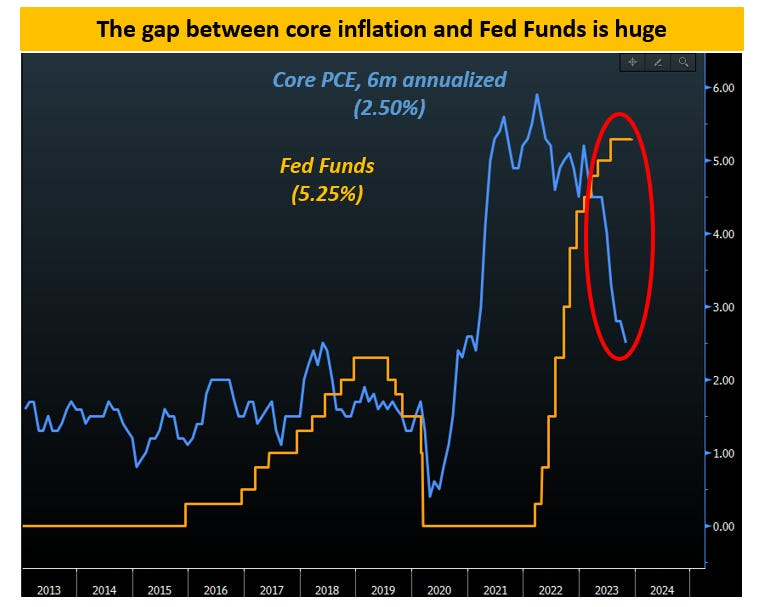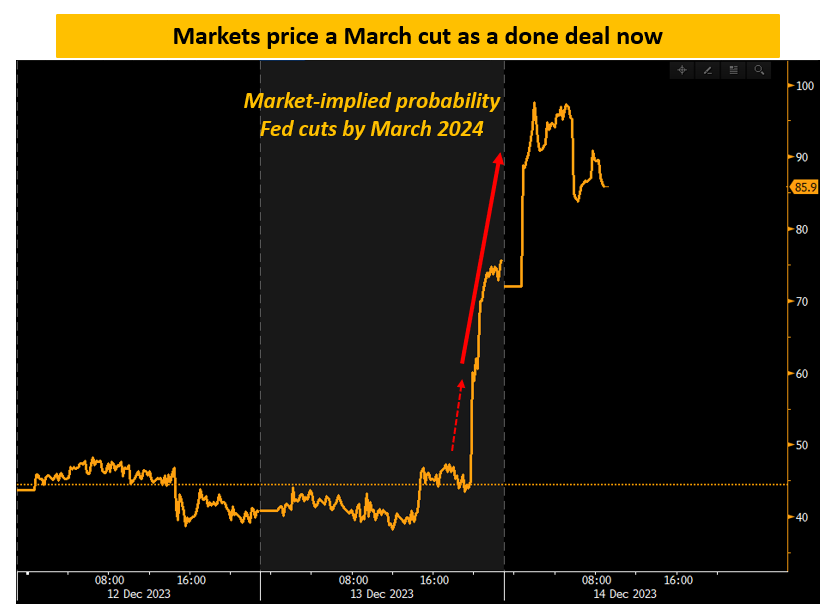We just got our January 2019 moment: the Powell dovish pivot is here.
Contrary to popular belief, a dovish pivot doesn’t mean the is already cutting rates.
Instead, it means the necessary conditions for cutting rates are relaxed, and the monetary policy stance isn’t ‘’we fight ’’ anymore but ‘’inflation is going down, hence we cut rates so we don’t remain ultra tight’’.
In Sintra 2017, ECB president Draghi pioneered this approach: as the Eurozone economy was recovering but ECB rates were negative he argued the ECB should start normalizing.
If rates were kept negative while the economy recovered, that was akin to adding more accommodation.
Powell’s dovish pivot relies on the same argument, seen from the opposite side: is trending around 2.5%, and Fed Funds are still 5.25% – the gap is getting enormous, and hence policy ultra tight.
Cutting rates here just maintains the same level of policy restrictions.
In other words, the Fed doesn’t want real Fed Funds at 3%+ (too restrictive) but at 1-1.5% (mildly tight).

Powell delivered his dovish pivot with 3 punchy headlines.
- ”It would be too late to wait for 2% CPI to reduce tightening; you want to do that well before 2%’’
This is the sentence incarnating a forward-looking Fed, not a reactive one.
The monetary policy stance has changed.
- ‘’When to start dialing in policy tightening was clearly a topic of discussion for the FOMC today’’.
Read: the Fed’s base case is a March cut already.
The important news here is that discussions about the timing of cuts have already started, so the FOMC has rapidly moved from talking about how long to pause to talk about when to cut.
This sentence propelled the probability of a cut in March higher and sent the bond market to the moon.
- ‘’Disinflation is broad: we have made meaningful progress on all three categories we watch’’
Powell had all the chances in the world to push back against this huge market rally.
He turned down every chance – even when asked about the nuances of inflation.
Core Services Ex-Housing is trending at 3.6%, and Shelter CPI has been slower to come down than expected.
Yet not a single pushback – instead Powell thinks ‘’disinflationary progress achieved in all categories’’.
This was a strong confirmation of the dovish pivot and the cherry on the cake for markets.
From a long-term asset allocation perspective, staying long bonds in October was the right choice.
The ‘’this time is different’’ crowd talking about a much higher term premium and ‘’the economy can handle 5% rates’’ was very vocal – and it was wrong.
Yet the rally in bonds has been gigantic: can we make sense of long-end Treasury yields here?
Are they still worth an overweight, or did we squeeze out most of the juice already?
How to correctly position long-term portfolios for 2024?
***
This article was originally published on The Macro Compass. Come join this vibrant community of macro investors, asset allocators and hedge funds – check out which subscription tier suits you the most using this link.


